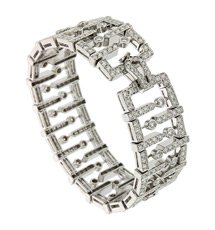A diamond is a mineral consisting of over 99.95% crystalized carbon, its atomic structure making it the hardest natural substance known to man. They form between 75 and 120 miles below the earth’s surface, where the temperature and pressure are powerful enough to form this unique gem. Volcanic eruptions from over 50 million years ago sent these stones to the earth’s crust.  Geologists believe that the first delivery occurred more than 2.5 billion years ago. Upon reaching the surface, a number of diamonds settled back into their volcanic pipes. Others were washed hundreds of miles away by floods and rivers, and some reached the oceans and drifted back onto the beach. The first diamond mines appeared in India before 500 BC.
Geologists believe that the first delivery occurred more than 2.5 billion years ago. Upon reaching the surface, a number of diamonds settled back into their volcanic pipes. Others were washed hundreds of miles away by floods and rivers, and some reached the oceans and drifted back onto the beach. The first diamond mines appeared in India before 500 BC.
India has been the world’s major supplier of wholesale diamonds for over 2,000 years, producing some of the most famous diamonds. Today, the country accounts for only a tiny percentage of the world’s wholesale diamond production, with Australia, Botswana, Russia, South Africa, Zaire and Canada now leading loose diamond production.
Before transforming into a beautiful piece of fine jewelry, the diamond must undergo several stages.
Stage 1 – Mining
Diamonds that made it to the surface were forced through volcanic kimberlite pipes, which consist of a large vertical shaft with tunnels running from the main channel. The deepest mine runs about 3,500 feet down into the earth. Finding diamonds and getting them out of the ground may require the use of jet engines to thaw the frozen ground or to endure sweltering desert heat. More than 200 tons of rock, gravel and sand need to be crushed and processed to yield a single carat of gem quality diamonds. Only about 20% of all rough diamonds are suitable for polishing and selling as wholesale loose diamonds; the rest are used for industrial purposes. Once the rough is found the diamond’s journey continues.
Stage 2 – Rough Reaches the Market
A large proportion of the world’s rough diamond supply finds its way to De Beers’ Central Selling Organization (CSO). The CSO’s rough is sorted into more than 5,000 different categories before reaching the wholesale diamonds production level. Once the diamonds are sorted and priced, they are sold to manufacturers at events known as sights. There are ten sights a year; each lasting a week. The chosen few authorized to purchase at these sights are called sightholders. The balance of the world’s rough supply is sold to private organizations and individuals, and some through private auctions.
Stage 3 – Manufacturing the Diamond
Regardless of the source, all rough eventually finds its way to the world’s cutting centers. Today, the major centers are Antwerp, Israel, Bombay, Johannesburg, and New York. Upon reaching its destination the rough is carefully examined to decide how it should be cut to yield the greatest value. After taking into consideration the rough’s size shape, as well as the number and position of its internal inclusions, the stone is marked and usually sawed or cleaved. The stone then goes through a series of specialized cutters before it is polished and ready for sale on the wholesale loose diamonds market.
Stage 4 – The Final Journey
After a diamond is manufactured, it’s ready to resume its journey. For decades, diamond firms have sold their cut gems to jewelry manufacturers and diamond wholesalers, who then resell their diamonds to retail stores. Today’s technology is changing the diamond pipeline. Diamond manufacturers now have a direct link to the final customer, particularly through online channels, though many companies maintain a blend of physical and digital stores.





